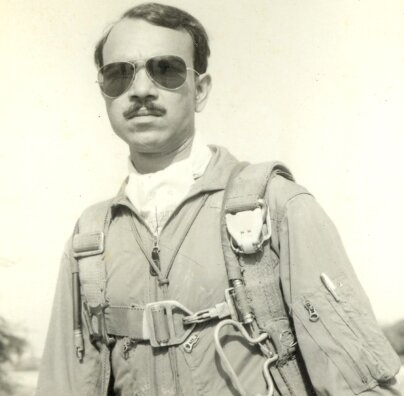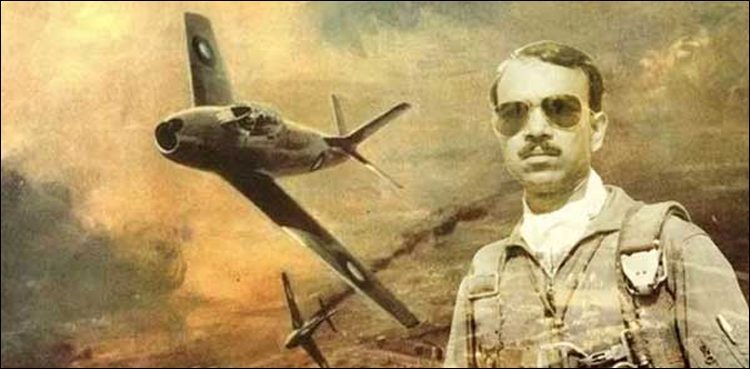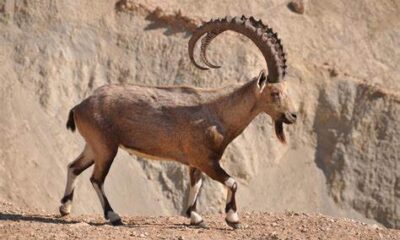Article
Real-Life “TOP GUN” M.M. ALAM
Published
3 months agoon
By
EDITOR
Muhammad Mahmood Alam, often referred to as M.M. Alam, was a legendary Pakistani fighter pilot who gained fame during the 1965 Pak-Indo War. He is celebrated for his exceptional skills and courage in combat, particularly for downing five Indian Hawker Hunter fighter aircraft in a single dogfight in less than a minute. This remarkable achievement earned him the nickname “Little Dragon” and solidified his reputation as one of Pakistan’s most celebrated fighter pilots.

M.M. Alam’s extraordinary feat of shooting down five enemy aircraft in such a short span of time is still regarded as one of the most significant accomplishments in aerial combat history. He was an inspiration to generations of Pakistani pilots and remains a symbol of bravery and skill in the Pakistan Air Force’s history.
While the term “Top Gun” is often associated with elite fighter pilots, it’s essential to note that M.M. Alam achieved legendary status not only within Pakistan but also on the international stage due to his exceptional combat performance. His legacy as a real-life “Top Gun” endures in the annals of aviation history
M.M. Alam’s Aircraft: The F-86 Sabre and the Indian Hawker Hunter
M.M. Alam’s Aircraft: The F-86 Sabre
1. Overview:
- Type: Fighter aircraft
- Manufacturer: North American Aviation
- Role: Air superiority fighter and ground attack
- First Flight: October 1, 1947
- Introduced: 1949
- Primary User: United States Air Force (USAF), also used by Pakistan Air Force (PAF) and various other air forces globally
2. Design and Features:
- The F-86 Sabre was a transonic jet fighter aircraft that became one of the most prominent American fighter planes during the Korean War and throughout the early Cold War period.
- Engine: Powered by a General Electric J47 turbojet engine, capable of producing about 5,200 lbf of thrust.
- Speed: The Sabre could reach a top speed of approximately 687 mph (Mach 0.9), making it one of the fastest jet fighters of its time.
- Armament: The aircraft was equipped with six .50 caliber M3 Browning machine guns mounted in the nose. It could also carry bombs and rockets for ground attack missions.
- Maneuverability: The Sabre’s swept-wing design contributed to its excellent maneuverability at high speeds, which was crucial during dogfights.
- Combat Role: The F-86 Sabre was primarily designed for air-to-air combat but was versatile enough to perform ground-attack missions. Its agility and speed made it a formidable adversary in dogfights, particularly against Soviet-built MiG-15s during the Korean War.
3. M.M. Alam and the F-86 Sabre:
- During the 1965 Indo-Pak war, M.M. Alam flew the F-86 Sabre and achieved extraordinary success in aerial combat.
- Alam’s mastery of the Sabre was evident in his ability to outmaneuver and outshoot the Indian Air Force’s (IAF) more modern aircraft, particularly the Hawker Hunter.
- His most famous achievement came on September 7, 1965, when he shot down five IAF Hawker Hunters in less than a minute using the F-86 Sabre, setting a world record for the fastest air-to-air kills.
Indian Aircraft: The Hawker Hunter
1. Overview:
- Type: Fighter aircraft
- Manufacturer: Hawker Aircraft
- Role: Fighter-bomber, ground attack, and interceptor
- First Flight: July 20, 1951
- Introduced: 1954
- Primary User: Royal Air Force (RAF), Indian Air Force (IAF), and various other air forces globally
2. Design and Features:
- The Hawker Hunter was a transonic British jet fighter that served as the primary front-line fighter for the Royal Air Force and was extensively used by the Indian Air Force during the 1965 Indo-Pak war.
- Engine: Powered by a Rolls-Royce Avon turbojet engine, producing between 7,500 lbf and 10,150 lbf of thrust depending on the variant.
- Speed: The Hunter could reach a top speed of approximately 715 mph (Mach 0.94).
- Armament: The Hunter was equipped with four 30mm ADEN cannons and could carry a variety of bombs, rockets, and missiles for air-to-ground and air-to-air combat.
- Maneuverability: The Hunter was known for its smooth handling, robust design, and reliability. Its performance made it a popular aircraft among pilots.
- Combat Role: The Hawker Hunter served as both an interceptor and a ground-attack aircraft. Its versatile design allowed it to be used in multiple roles, from air superiority missions to close air support.
3. Indian Air Force and the Hawker Hunter:
- The Hawker Hunter was one of the primary aircraft used by the Indian Air Force during the 1965 Indo-Pak war. It was considered a superior aircraft to many of the older jet fighters in service at the time.
- Despite the Hunter’s technological advantages, M.M. Alam’s exceptional flying skills allowed him to defeat these aircraft decisively during dogfights, most notably in the skies over Sargodha.
- The Hunter was involved in several key air battles during the conflict, and its pilots were often engaged by PAF’s F-86 Sabres, including those flown by M.M. Alam.
Comparative Analysis
**1. Technological Comparison:
- F-86 Sabre: Despite being older and less powerful compared to the Hawker Hunter, the F-86 Sabre was highly maneuverable and had a combat-proven track record. It was an agile and reliable aircraft, particularly effective in dogfights.
- Hawker Hunter: The Hunter was a more modern aircraft with better speed, armament, and avionics. It had a higher top speed and could carry a more diverse payload, making it more versatile in various combat roles.
2. Tactical Superiority:
- M.M. Alam’s Tactical Genius: The technological edge of the Hawker Hunter was effectively neutralized by M.M. Alam’s superior tactics, quick decision-making, and precise shooting. His deep understanding of the F-86 Sabre’s capabilities allowed him to exploit its strengths and outmaneuver the Hunters.
- Dogfight Success: Alam’s ability to down five Hawker Hunters in under a minute was not just a demonstration of his flying skills but also a reflection of his deep tactical acumen. He capitalized on the Sabre’s strengths, such as its rapid acceleration and tighter turning radius, to dominate the aerial battle.
3. Historical Impact:
- Legacy of the F-86 Sabre: The success of the F-86 Sabre in the hands of pilots like M.M. Alam has become a celebrated chapter in military aviation history. The aircraft, despite its age, proved that skill and strategy could triumph over technological superiority.
- Role of the Hawker Hunter: While the Hawker Hunter was a formidable aircraft, its performance in the 1965 war, particularly against M.M. Alam, highlighted the importance of pilot expertise and tactical proficiency in determining the outcome of air engagements.
Conclusion
The aerial battles between the F-86 Sabre and the Hawker Hunter during the 1965 Indo-Pak war are a testament to the enduring truth that while technology plays a critical role in modern warfare, it is the skill, strategy, and courage of the pilot that ultimately determine victory. M.M. Alam’s legendary feats in the F-86 Sabre against the Indian Hawker Hunters remain one of the most remarkable stories in the history of aerial combat, and they continue to inspire future generations of fighter pilots around the world.

You may like
-


Unity, Faith, and Discipline: The Cornerstones of Pakistan’s Motto as “Aik Qaum” (One Nation)
-


Aik Qaum: The Fusion of Integrity and Patriotism
-


“AIK QAUM” DECLARATION OF CONCEPTION
-


Dr. Abdul Qadeer Khan: The Real Hero of Pakistan
-


The Chiltan Ibex: A Rare Treasure of Balochistan
-


“Rising above the rugged terrain of Balochistan, Koh-i-Chiltan stands as a symbol of mystery and resilience.”
Article
Aik Qaum: The Fusion of Integrity and Patriotism
Published
3 weeks agoon
May 28, 2025By
EDITOR
We keep Integrity closest to our Heart and Patriotism on top of our mind.
Integrity and patriotism are not separate entities; they are intertwined in the soul of Pakistan. The people understand that to be a patriot is to uphold the principles of integrity. Honesty and love for one’s country are two sides of the same coin. Together, these values form the essence of “Aik Qaum.”
The fusion of integrity and patriotism is evident in the everyday lives of Pakistanis. It’s in the farmer toiling the fields, the teacher educating the youth, and the soldier guarding the borders. It’s in the child who dreams of a better Pakistan and the elderly who have seen the nation grow. “Aik Qaum” is the realization that integrity and patriotism are the heart and mind of Pakistan, beating in unison to guide the nation forward.
As we celebrate the spirit of “Aik Qaum,” we honor the values that make Pakistan a unique and resilient nation. Integrity and patriotism serve as our guiding stars, leading us towards a brighter and more prosperous future. In the heart of every Pakistani and at the forefront of their minds, “Aik Qaum” stands as a testament to the strength of a united nation, bound by the principles of integrity and the unyielding love for their homeland.
In Pakistan, “Aik Qaum” is not just a motto; it’s a way of life that embodies the enduring spirit of a proud and united nation.

Our Initiative
The fabric of the Pakistani nation has something unique in its knit, something signature and so sanguine that could keep on energizing its very fibers irrespective of the floods of considerably tough challenges posed against it since its inception. There is also a belief that Pakistan has been blessed with such a golden glitter that couldn’t be ignored by any sensible system of reason and knowledge among the league of free, upright and kind nations. The credit goes to the amazing people of Pakistan. It is more exciting to find that the people of Pakistan, be it the businessmen, doctors, parents, soldiers, students, teachers, judges, labourers or lawyers etc, have assumed the duty bestowed upon them by the founder of the nation, Quaid-e-Azam Muhammad Ali Jinnah decades ago. Quaid once said “If you will work in cooperation, forgetting the past, burying the hatchet, you are bound to succeed.” At another occasion, Quaid summed this message up in just three words: Unity, Faith and Discipline. AIKQAUM.COM is an initiative built upon the idea of translating this vision of the founder of Pakistan, Quaid-e-Azam Muhammad Ali Jinnah into a fruitful action.
There is no power on earth that could restrict us from finding those beautiful commonalities among the people of this beautiful nation. It contends to promote the psyche morale of the Pakistani nation by addressing the issues instead of dodging them. We have a team of thorough professionals fully equipped to create unique platforms, forums and projects which will bring people closer on all sensitive issues related to our national identity and progress. We also have a strong support network for successful execution of all our campaigns in order to induce greater cohesion and the spirit of coexistence across the length and breadth of Pakistan. Coincidentally, we are living through an age of increased morphing of warfare in a world that’s once again moving from unipolar to a multipolar turf. The social, political, economic and technological factors shaping the evolution of warfare are being constantly experimented and employed in our own region. In a time of increased friction between regional powers and a heightened threat on the eastern border, Pakistan faces multiple challenges posed at its internal, external and economic security.
All these factors, blended with our archrival’s constant image building campaigns, a heavily funded lobbying in the West, the new Indo-US strategic alliance, as well as India’s ambition to start a space race, puts our nation on caution and throws immense burden of responsibility on our shoulders. We are witnessing a rise of sub conventional warfare fought with guns and bombs, but won on keyboards and drawing boards. AIKQAUM.COM aspires to be a strong force of defense against the subversive forces that are trying to malign Pakistan and hurt our interests in the region. We are fully trained and equipped to meet the challenges on the social and digital front.
www.aikqaum.com, info@aikqaum.com
Our Philosophy
VISION:
To create a social awareness about the values which join our nation together while countering anti-Pakistan narratives with logical and practical rationale.
MISSION:
To infuse a sense urgency for cohesion among all ethnic, political and religious schools of thought.
VALUES:
We keep integrity closest to our heart and patriotism on top of our mind. Our work ethics and commitment to our people shall empower us to achieve success in all our pursuits.
Article
The Chiltan Ibex: A Rare Treasure of Balochistan
Published
2 months agoon
April 16, 2025By
EDITOR
The Chiltan ibex (Capra aegagrus chiltanensis), a subspecies of the wild goat, is one of the most unique and endangered animals native to Pakistan. Found exclusively in the rocky highlands of the Chiltan range within the Hazarganji-Chiltan National Park in Balochistan, this elusive animal represents the region’s rich biodiversity and ecological heritage.
Physical Characteristics
The Chiltan ibex is a strikingly beautiful species, with a robust, muscular build perfectly suited for navigating steep and rocky terrains. Males are particularly distinctive, boasting impressive curved horns that can grow up to 30 inches (76 cm) in length. Their coat is light brown, with a darker stripe running along their back and legs, providing excellent camouflage in their arid mountainous habitat.
Females are smaller in size with shorter, more slender horns, and their coloration is less pronounced, blending seamlessly into their surroundings. This camouflage helps protect them and their offspring from predators such as wolves and large birds of prey.
Habitat and Range
The Chiltan ibex inhabits the rugged, semi-arid regions of the Chiltan range, located within the Hazarganji-Chiltan National Park, southwest of Quetta. These high-altitude areas, ranging from 1,500 to 3,200 meters above sea level, are characterized by rocky cliffs, sparse vegetation, and extreme weather conditions.
The ibex is well-adapted to this challenging environment, where it feeds on grasses, shrubs, and the leaves of juniper trees. Its ability to climb steep slopes and jump across narrow ledges gives it a unique advantage in escaping predators and surviving in such inhospitable terrain.
Behavior and Social Structure
Chiltan ibexes are diurnal, meaning they are active during the day. They are typically found in small groups, with herds consisting of females and their young. Males are more solitary, joining herds only during the breeding season, which occurs in the late autumn and winter months.
During this time, males engage in dramatic displays of strength to compete for mating rights, including horn clashing and dominance rituals. After a gestation period of around six months, females give birth to one or two kids in spring, when food availability is higher.
Conservation Status
The Chiltan ibex is classified as endangered due to its restricted range, habitat loss, and poaching. Habitat degradation caused by overgrazing, deforestation, and human encroachment poses significant threats to its survival.
Historically, the ibex faced heavy hunting pressure for its horns, considered a symbol of prestige, and for its meat. Although hunting is now banned in the national park, illegal poaching remains a concern.
Conservation Efforts
To protect the Chiltan ibex and its fragile ecosystem, the Hazarganji-Chiltan National Park was established in 1980. Spanning over 32,500 acres, the park provides a safe haven for the ibex and other wildlife, such as wolves, foxes, and birds of prey.
Conservation efforts include:
- Anti-Poaching Measures: Increased patrolling and strict enforcement of hunting bans have helped reduce poaching incidents.
- Habitat Restoration: Programs to control overgrazing and reforest juniper woodlands are underway to restore the ibex’s natural habitat.
- Public Awareness Campaigns: Local communities are being educated about the importance of biodiversity and the role of the Chiltan ibex in maintaining ecological balance.
- Eco-Tourism Initiatives: Promoting responsible tourism generates revenue for conservation projects and raises awareness about the ibex’s plight.
Ecological Importance
The Chiltan ibex plays a vital role in its ecosystem as both a grazer and prey species. By feeding on shrubs and grasses, it helps maintain vegetation balance, preventing overgrowth and contributing to soil health. At the same time, it serves as a food source for predators, sustaining the natural food chain.
Protecting the ibex is not just about saving a single species—it’s about preserving an entire ecosystem that supports numerous forms of life, from tiny insects to apex predators.
Cultural Significance
For the people of Balochistan, the Chiltan ibex is more than just a wild animal; it is a symbol of the region’s natural beauty and resilience. Local folklore often intertwines with the ibex, celebrating its agility and strength. The species also draws international attention, making it a flagship for wildlife conservation in Pakistan.
The Future of the Chiltan Ibex
While conservation efforts have shown promise, the Chiltan ibex remains vulnerable. Protecting this rare species requires continued collaboration between government agencies, conservation organizations, and local communities.
By safeguarding the Chiltan ibex, we not only preserve a unique animal but also protect the fragile ecosystem of Balochistan, ensuring that future generations can marvel at the beauty and resilience of this incredible species.
The Chiltan ibex is a testament to nature’s ability to adapt and survive in the harshest of environments. As efforts to protect it continue, this majestic animal stands as a beacon of hope for wildlife conservation in Pakistan.

Unity, Faith, and Discipline: The Cornerstones of Pakistan’s Motto as “Aik Qaum” (One Nation)

Aik Qaum: The Fusion of Integrity and Patriotism








